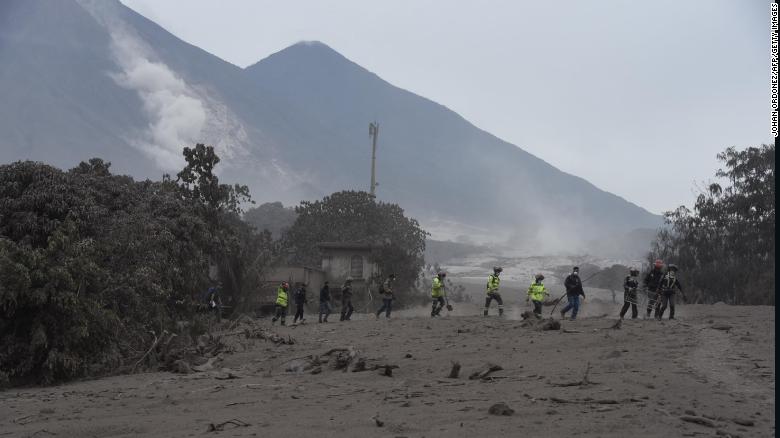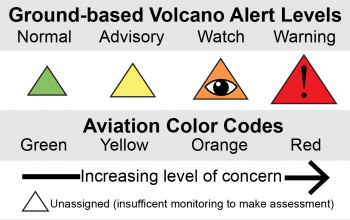Have you seen the destruction that volcanoes can cause from the recent tragedies in the news? Did you know that there are over 1500 active volcanoes around the world? There are 169 inside the U.S. alone, 50 of which are being constantly monitored as high risk! So what do you do if you are near an eruption? How do you prepare? Here are some information and tips on how to prepare for the next eruption.
 On Sunday June 3rd the Fuego volcano erupted in Guatemala, resulting in over 69 deaths (that is at least ten more deaths than when Mount St. Helens erupted in 1980). Rescuers went to find survivors despite the scalding ash fall. The volcanic ash spread in a 12 mile radius, and more than 1.7 million people were affected.
On Sunday June 3rd the Fuego volcano erupted in Guatemala, resulting in over 69 deaths (that is at least ten more deaths than when Mount St. Helens erupted in 1980). Rescuers went to find survivors despite the scalding ash fall. The volcanic ash spread in a 12 mile radius, and more than 1.7 million people were affected.  On May 3rd Kilauea erupted on the Big Island of Hawaii, and the effects are still occurring. Luckily no one was killed, but significant damage was left in its wake. 117 homes were destroyed, and at least 22 fissures/cracks opened up creating a greater lava flow.
On May 3rd Kilauea erupted on the Big Island of Hawaii, and the effects are still occurring. Luckily no one was killed, but significant damage was left in its wake. 117 homes were destroyed, and at least 22 fissures/cracks opened up creating a greater lava flow.
What History Has to Say
Many know of the devastation that resulted from the Mount St. Helens eruption of May 18th, 1980. 57 people were killed, and it caused over $1.1 billion in damages. Forest fires started due to the hot ash, and 900,000 tons of ash had to be removed from areas around and in Washington state.
According to the New York Times, "Officials say the mountain, which erupted explosively in 1980, is the most likely volcano in the 48 contiguous states to erupt again".
What the Future Holds
Activity levels are based on the picture to the left. It shows that green is normal activity, yellow means that there is unusual activity, orange shows that there is more concern, and red means volcanic activity is imminent.
Yellowstone's Supervolcano
Volcanoes in the U.S., and around the world
As previously mentioned there are over 1500 active volcanoes around the world, 169 of which are in the U.S. Here is how experts classify their status:
The United States Geological Survey has an interactive map of U.S. volcanoes and the current activity levels, as seen below.
Most of the volcanoes are around the North Pacific Ocean. This is also known as the "Ring of Fire". It is estimated that about 80% of earthquakes strike within this area.
Yellowstone's Supervolcano
One of the volcanoes in the Ring of Fire is the one in Yellowstone, Wyoming.
David Rothery, a professor of Planetary Geosciences at Open University, has said that the eruption of Yellowstone's supervolcano could lead to a "'nuclear winter' of volcanic ash choking out the sun from the skies", affecting the entire world. Yellowstone's supervolcano has had three "recent" major eruptions that occurred: 2 million years ago, 1.3 million years ago, and 630,00 years ago. Some speculate that this means another eruption is overdue, however opinions are mixed as others expects predict another eruption won't occur for 1-2 million years.
It is likely the eruption wouldn't wipe out humanity, but it certainly would be destructive, especially to human, plant, and wildlife in the western half of the United States.
So how does Yellowstone's volcano compare to other eruptions in the past:
Earlier in this blog we talked about the destruction caused by the 1980 eruption of Mount St. Helens, but while tragic, as seen on the image above that compares other volcanic eruptions, it was relatively small.
What does this mean if a volcano the size of Yellowstone's were to erupt? The following is predicted:
So what is the good news?
David Rothery, a professor of Planetary Geosciences at Open University, has said that the eruption of Yellowstone's supervolcano could lead to a "'nuclear winter' of volcanic ash choking out the sun from the skies", affecting the entire world. Yellowstone's supervolcano has had three "recent" major eruptions that occurred: 2 million years ago, 1.3 million years ago, and 630,00 years ago. Some speculate that this means another eruption is overdue, however opinions are mixed as others expects predict another eruption won't occur for 1-2 million years.
It is likely the eruption wouldn't wipe out humanity, but it certainly would be destructive, especially to human, plant, and wildlife in the western half of the United States.
So how does Yellowstone's volcano compare to other eruptions in the past:
What does this mean if a volcano the size of Yellowstone's were to erupt? The following is predicted:
- 4 inches of ash will cover the ground, and kill the crops in the Midwest
- Acid rain and global cooling would occur due to the gasses released from the lava
- The image below shows an estimation of who would be affected by the eruption of Yellowstone's supervolcano. Granted, it would depend on the eruption itself, and the wind.

So what is the good news?
- This is a volcano that is constantly being monitored, and it currently poses no threat to humanity.
- The United States Geological Survey has said that the likelihood of Yellowstone erupting is a 1 in 730,000 chance of occurring; i.e. 0.00014% chance.
- Because of how far we have come with monitoring volcanic activity, it is predicted that we would know the eruption was going to happen weeks, months, or even years before the eruption actually occurred. this would allow residents in areas of potential risk to evacuate.
- Even with Yellowstone being geologically active, past major earthquakes in the area have not lead to any issues with the supervolcano. Rather they created more geyser activity, and smaller volcanic lava flow.
How to Prepare for a Volcano
There is hope, and there are many things that a person can do to prepare for a volcanic eruption. In a previous blog we talk about what you should do if you experience volcanic ash, and/or acid rain in your area. Here is the link to that blog. However, those are things to do after an eruption. There is much to do before the eruption even occurs. Here is a video we liked:
Ready.gov has given the following advice:
- Know the risks in your area
- Know local evacuation routes, and where you are to go if there is an eruption
- Know about local warning systems
- Have an emergency kit
- Learn if you have any respiratory
- Have a family evacuation and communication plan
- Keep important documents in a safe place
- Know what your insurance policy is when it comes to volcanoes
Volcanoes affect us all whether we live near one or not. The future is unpredictable, and therefore we need to make sure we are prepared. Don't wait until chaos is upon you. Know the risks in your area, and come up with a plan to keep your family safe. For more information on volcanoes, refer to the video below.









No comments:
Post a Comment